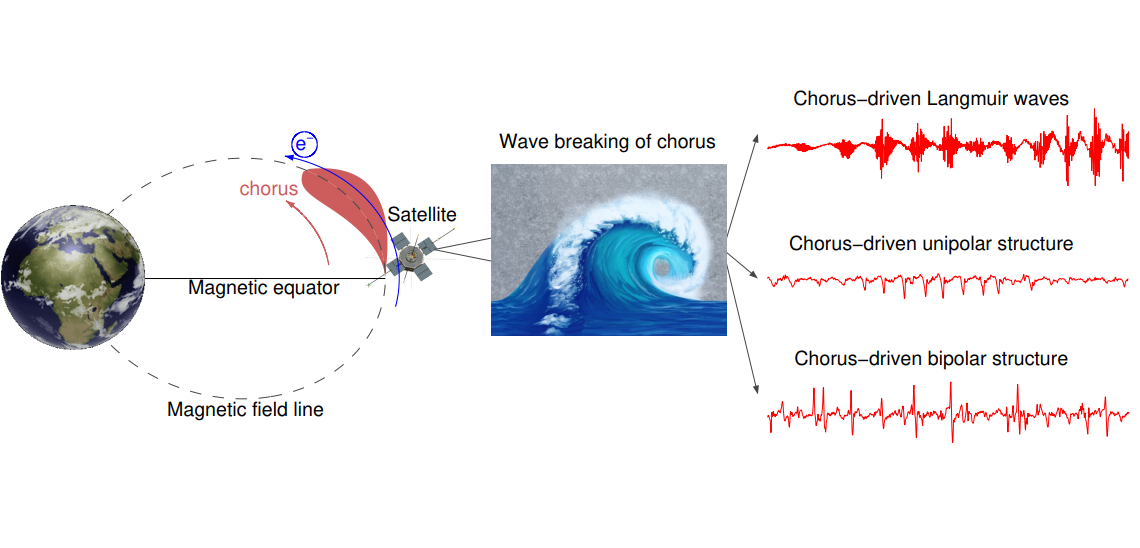There are tons of natural processes that we aim to understand, and postdocs Xin An and Jinxing Li, with Jacob Bortnik as their faculty advisor, recently found an explanation to one of these unknown phenomenons. Xin An, a recent UCLA graduate (PhD Space Physics, 2017) has worked with Bortnik since his PhD and now continues to work on solving the world’s unknowns with him as a postdoctoral fellow. A love for solving hard problems, especially those pertaining to the natural physical world, had Bortnik excited to be a part of this research that explains the previously unexplainable.
There are various satellites orbiting Earth that can observe different radio waves and since the launch of NASA’s Van Allen Probes, space physicists have observed many “electrostatic” wave structures as well. These electrostatic waves, “a type of disturbance only seen in the electric field” have been studied by scientists because they are not yet understood, and they may have a follow-on effect on particles, which accelerates them in a chain that leads up to extremely high energy radiation belts.
There are three notable types of these electrostatic structures that our scientists, Li and An have studied closely to explain the origin. These include unipolar structures, which the electric field predominantly varies in one direction, bipolar structures, which the electric field varies in both the positive and negative directions, and the electrostatic Langmuir waves that are high frequency waves that can propagate.
With the Large Plasma Device at UCLA, satellite data, funding from NASA/H- TIDeS program, and the expertise available here, these researchers went to work on explaining such uncharted connections and effects of the Langmuir waves and unipolar and bipolar structures. With the extent of knowledge here at UCLA, the ideas of nonlinear physics, computational physics, lab plasma physics, and so much more were bounced around with ease, until the explanation was clear. This university provided a “scientific ecosystem” for this research to take place. The team of three have created a clear explanation of how chorus waves can trap electrons in their potential, and these trapped electrons can excite Langmuir waves, unipolar, and bipolar electric field structures. The world of space physics is now enlightened by the fact that these range of seemingly different nonlinear wave structures can be unified under the same electron trapping process by whistler-mode chorus waves. Due to this research specifically, people can recognize the link between these structures.

This discovery can be thought of as similar to an ocean wave breaking. The electrons trapped in the potential chorus waves can induce instabilities and break the original wave potential, causing small electrostatic structures to disrupt the original potential of chorus waves.
Xin An, carried out this research on one of the most powerful supercomputers in the US, in order to run the theoretical simulations. While Jinxing Li, built off of their past paper that showed that these Langmuir waves are closely related to a much lower frequency electromagnetic whistler-mode wave called “chorus waves,” to provide the observational component using electrostatic data observed by satellites. These waves can trap electrons in their wave potential and thus excite Langmuir waves, unipolar, and bipolar structures by varying only one parameter of the wave.
In the end An, Li, and Bortnik have provided the world with a “simple and elegant unified explanation of the origin of these three electrostatic structures.” This is a groundbreaking explanation, as this phenomenon has been observed in space for many years, and has shown the possible physical effect, with no clear explanation until now.
Bortnik explained that this research focuses on basic plasma physics, which is what makes up the cosmos, and thus nature. “We are trying to understand the basic material of the cosmos at the most fundamental level, how the particles behave, interact with each other, create waves and respond to those waves.” There was no previous evidence that these waves and structures were linked to such an elegant and simple underlying physical process.
With this research done, it is now possible to peer into the underlying microphysical processes that trap electrons in waves. These researchers now question if this process manifests itself in other situations, including shocks and rapid particle injections into the magnetosphere. They also question this proven processes place in the bigger picture of energy cascape with other planets.
Bortnik mentioned that this research must continue to develop, because “it is very important for humans to have a deep appreciation of the physical world, and that appreciation comes from taking time and effort to understand it.” Physics is a way of looking at the world, it’s about discovering “the hidden connections between different physical phenomena or different physical systems to create a unified view of the physical world.” This team is made of scientists who appreciate and are constantly amazed by nature, which drives them to figure out an explanation for the unknowns.
Jinxing Li wrote a piece about his work for the Astronomy Community with Nature, check it out here.
Story by Ciara Kelly
Tags: News
 Large Plasma Device at UCLA
Large Plasma Device at UCLA